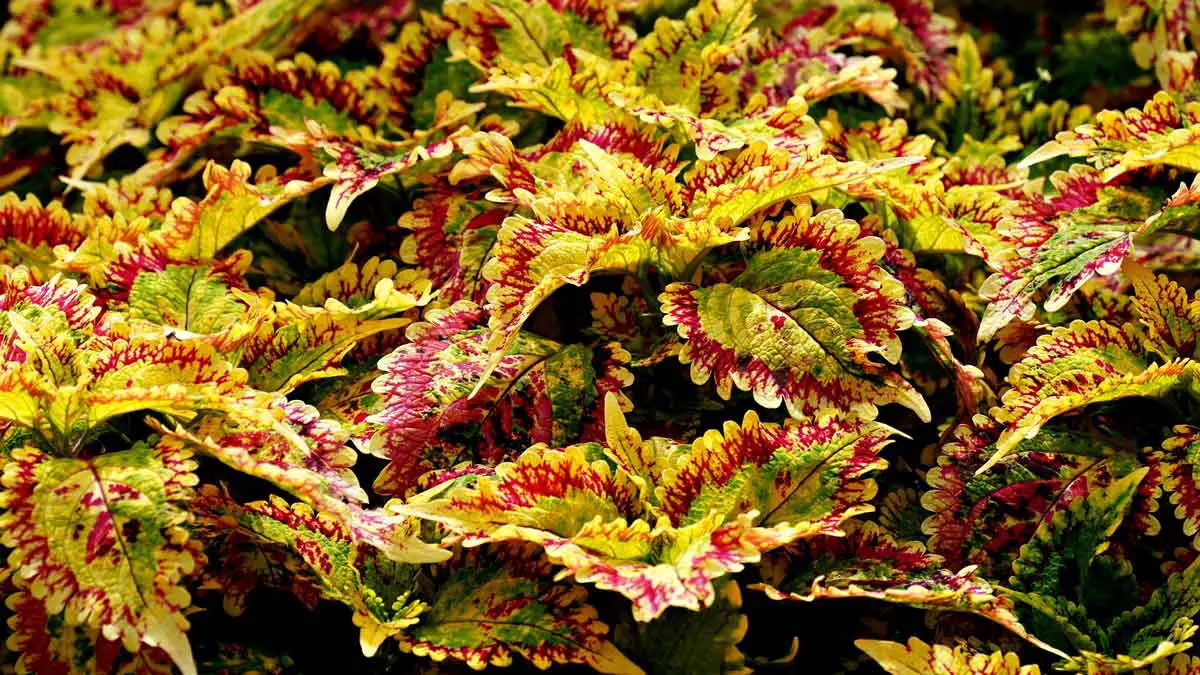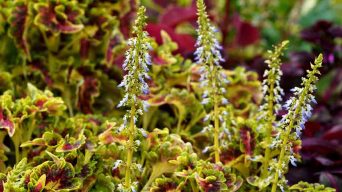To make a Coleus plant more bushy, it is recommended to pinch the tips of the stems and leaves. This practice helps to promote branching and full growth, leading to a fuller, bushier plant. Additionally, cutting the plant back when it reaches approximately 6 inches in height can contribute to a more robust, bushy appearance.
Coleus is a popular houseplant known for its bright and colorful leaves. It is easy to care for and can be grown indoors or outdoors, making it an ideal choice for gardeners of all levels.
Having a bushy coleus adds fullness and lushness to your garden, as well as improving the overall aesthetic appeal of your space.
If you would like to achieve the same look with your own coleus plant, this article will provide step-by-step instructions on how to make it bushier.
Understanding Coleus Growth Habits
Coleus plants can quickly and easily add a splash of vibrant color to your garden, provided they receive the proper care.
To ensure that the coleus fill out and become full, bushy plants with lots of lush foliage, it is important to understand their natural growth habits.
Natural Growth Habit of Coleus
Coleus plants have a natural growth habit that makes them tend to be slightly bushy. This trait can make them an excellent choice for gardeners who want a full, lush look in their gardens.
The plant’s natural habit is to grow in a dome shape, with the center of the plant forming a bushy mound.
Coleus is a tropical plant that grows quickly and can reach up to 3 feet tall in the right conditions, but when planted in containers, it will stay much smaller.
The plant will usually branch out from the center, producing multiple stems and leaves to create a full look.
However, without proper care, it can become leggy and sparse, so it is important to understand how to care for coleus in order to keep it looking healthy and lush.
Factors That Affect Growth
Light, water, soil, temperature, and pruning are all crucial elements in promoting growth and fullness of your coleus. To keep your coleus bushy, you need to monitor these conditions carefully.
When growing coleus plants in the right conditions, they will remain lush and full.
Providing the Right Environment to Promote Growth
Light Requirements
Coleus plants thrive in bright, indirect sunlight. They should be placed in a location that receives several hours of light each day but is shaded from direct sunlight.
This will help to ensure the plant maintains lush foliage without becoming scorched or burned by harsh sunlight.
When growing coleus indoors, it is best to place the plant near an east-facing window that receives bright morning sunlight. Outdoors, choose a spot with partial shade that receives dappled sunlight throughout the day.
Water Requirements
Coleus plants should be watered regularly, as they prefer consistently moist soil.
Allow the top inch of soil to dry out between waterings, but do not let it become completely dry or soggy.
To ensure the soil remains moist but not water-logged, it is best to water coleus plants in the morning and avoid watering them in the evening.
Always check the soil before watering, and water only when needed.
Soil Requirements
Coleus plants prefer a potting soil that is slightly acidic, with a pH of 6 to 7.
It should also be well-draining, as the plant does not like to stay soggy for extended periods of time.
A mixture of two parts potting soil and one-part perlite or coarse sand works well for coleus. Adding organic matter such as compost or peat moss can also help to improve soil fertility and drainage.
Temperature Requirements
Coleus plants are typically grown as annuals, but they can survive year-round in USDA Hardiness Zones 10 and 11.
In cooler climates, you may need to protect the plant from frost or snow during winter months.
Coleus plants prefer temperatures between 65-85°F (18-29°C) and should be kept away from cold drafts or extreme heat.
They don’t like extreme cold and will not tolerate temperatures below 50°F (10°C).
Pruning and Pinching
Importance of Pruning
Pruning helps to promote bushiness in your coleus and keep it healthy and attractive. It can also help control its height and size.
When pruning, you should cut back the stems just above the coleus leaves or where there are several sets of leaves growing from the same stem.
This will encourage new growth from that part of the plant, resulting in more branches and fuller foliage.
When to Prune a Coleus Plant
Pruning your coleus should be done on a regular basis to keep its growth healthy.
During spring and summer, when the coleus is actively growing, is the best time for pruning as it will help them remain bushy and full of vibrant color.
Pruning can be done any time of the year; however, if you wait too long between prunings, your coleus may become leggy or sparse.
It’s also better to prune in the late afternoon or evening, as this gives the coleus time to adjust to the change without being exposed to too much direct sunlight.
How to Prune and Shape Coleus
To keep your coleus looking its best, it’s important to prune and shape the plant regularly to stay bushy.
Here are some simple steps you can take to make sure your coleus remains full and lush:
- Start by removing any dead or dying branches. Make sure you get right down to the base of the branch, as new growth will emerge from there when pruned correctly.
- Then, use scissors or shears to trim off any overhanging branches that may be blocking the light from other parts of the plant. This will encourage even growth throughout the coleus and keep it looking bushy.
- Once you have removed any unwanted branches, you can start shaping the coleus by cutting back taller stems to create a more uniform look.
- If the center of your coleus is becoming too sparse, you can cut back some stems to let new growth emerge- this will give your coleus more volume and make it appear bushier.
- Lastly, pinch back the tips of the stems to encourage lateral growth. This will create a fuller and more bushier plant.
Benefits of Pinching
Pinching, which involves removing the growing tips from stems, is another way to encourage bushiness in coleus plants. This method will produce more side shoots and help your plant to stay compact.
You can pinch back the stems in spring or early summer with your fingers or a pair of sharp scissors.
Be sure to pinch back only the new growth and leave some of the older stems intact. This will ensure that your coleus stays full and bushy.
Pinching also helps to promote a more even growth throughout the plant, ensuring all parts of the coleus receive adequate sunlight and nutrients.
Pruning and pinching are important steps in keeping your coleus looking its best, so be sure to devote some time to these tasks regularly.
Fertilizing
Fertilizing is a vital step in helping your coleus stay bushy and healthy.
Using a balanced, water-soluble houseplant fertilizer will ensure that your coleus receives all the necessary nutrients to grow lush and full.
During the growing season, fertilize your coleus every 2-4 weeks and reduce it to once a month during winter when the plant does not actively grow.
When applying fertilizer, make sure you have watered the plant thoroughly first and always dilute according to the instructions on the label.
By providing regular doses of fertilizer throughout its life cycle, you can guarantee that your coleus will remain vibrant and symmetrical.
Additionally, by using a houseplant-specific fertilizer with low nitrogen content, you can limit leggy growth and encourage bushier foliage.
With careful attention to fertilizing requirements and proper soil nutrition, you’ll be rewarded with a beautiful display of color year-round!
Propagation
Propagating coleus plants helps produce a bushier look in your garden by increasing the number of plants and removing any damaged or diseased parts.
The most common and easiest method of propagation is through stem cuttings.
To propagate using this method, take a 4-6 inch cutting from a healthy part of the coleus plant and place it in moist soil or potting mix.
Before planting, dip the cut end in rooting hormone to help encourage root growth.
Place the coleus cutting in bright, indirect light and keep the soil consistently moist for best results.
Once roots have developed, you can transplant the new plant into a larger container or garden bed.
Another method of propagation is division. Coleus plants can be divided in early spring when the plant is in an active growing phase.
Carefully dig up the entire plant and divide it into sections, making sure that each division has a healthy root system intact.
Replant the divisions in moist soil and provide bright indirect light until established.
Finally, coleus can also be propagated through seeds.
To do this, sow the seeds in a well-draining soil mix and provide bright light and consistent moisture.
Once sprouts have appeared, thin out any overcrowded plants to prevent root competition.
With any propagation method, you can expect more bushy coleus plants with more flowering stems in your garden.
By increasing the number of coleus plants, you’ve also increased your chances of having a vibrant display that will last through the summer months.
So get propagating and enjoy a full and lush display of beautiful foliage!
Final Thoughts
Growing coleus is an easy and fun way to add a splash of color to any garden.
Knowing how to make coleus bushy will help you keep your plants healthy and looking their best.
Providing your coleus with proper care, including regular pruning, fertilizing, and watering, will go a long way in keeping your plants healthy and looking great.
Pruning can help encourage business, but also helps to keep your coleus from becoming too large and encourages new growth.
Be sure to fertilize regularly and water deeply when needed.
With the right care and attention, you’ll have a beautiful garden filled with healthy coleus plants that will brighten up any space.







